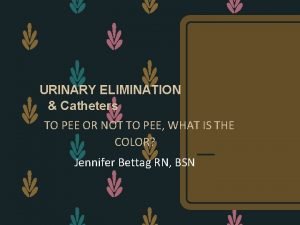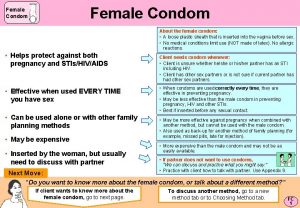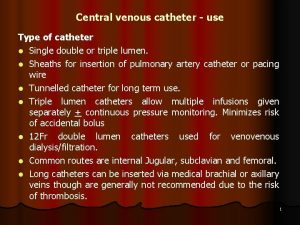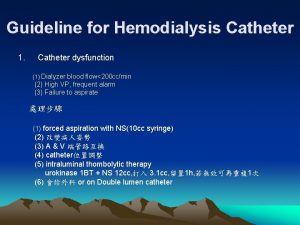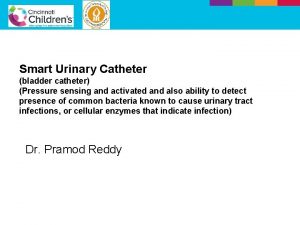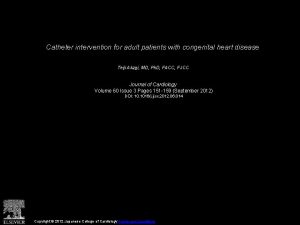second year Applying an External Condom Catheter Adult



















- Slides: 19

second year Applying an External Condom Catheter Adult Nursing Department ﻣﺮﻭﺓ ﺣﻤﺪﻱ ﺍﺣﻤﺪ / ﻡ

Definition: is an external catheter used for the treatment of urine incontinence in men. This external catheter is not a true catheter, as it is not inserted into the body cavity duct or vessel.

Purpose: To allow for urinary drainage externally while maintaining skin integrity and prevention of urinary tract infection.

Equipment: 1. Condom in appropriate size 2. Bath blanket 3. Basin of warm water and soap 4. Washcloth and towel 1. Skin protectant 2. Reusable leg bag with tubing or urinary drainage setup 3. Disposable gloves 4. Scissors

Procedure: Step 1: Bring necessary equipment to the bedside. Rationale: conserves time and energy Step 2: Perform hand hygiene and put on PPE, if indicated. Rationale: prevent the spread of microorganisms. Step 3: Identify the patient. Rationale: ensures the right patient receives the intervention and helps prevent errors.

Step 4: Close curtains around bed and close the door to the room, if possible. Rationale: This ensures the patient’s privacy Step 5: Explain the procedure with patient. Rationale: promotes reassurance Step 6: Ask the patient if he has any allergies, especially to latex. Rationale: Some condom catheters are made of latex.

Step 7: Adjust bed to comfortable working height. Rationale: prevents back and muscle strain. Step 8: Stand on the patient’s right side if you are right-handed, or on patient’s left side if you are lefthanded. Rationale: Positioning on one side allows for ease of use of dominant hand for catheter application.

Step 9: Prepare urinary drainage setup or leg bag for attachment to condom sheath. Rationale: Provides for an organized approach to the task. Step 10: Position patient on his back with thighs slightly apart. Rationale: Positioning allows access to site.

Step 11: Drape patient so that only the area around the penis is exposed. Rationale: Draping prevents unnecessary exposure and promotes warmth. Slide waterproof pad under patient. Step 12: Put on disposable gloves. Rationale: Prevent contact with body fluids.

Step 13: Trim any long pubic hair that is in contact with penis. Rationale: Prevents pulling of hair by adhesive without the risk of infection associated with shaving. Step 14: Clean the genital area with washcloth, skin cleanser, and warm water. Rationale: Washing removes urine, secretions, and microorganisms

Step 15: Clean the tip of the penis first, moving the washcloth in a circular motion from the meatus outward. Wash the shaft of the penis using downward strokes toward the pubic area. Rinse and dry. Rationale: The penis must be clean and dry to minimize skin irritation Step 16: Remove gloves. Step 17: Perform hand hygiene again.

Rationale: Reduce transmission of infection Step 18: Apply skin protectant to penis and allow drying. Rationale: minimizes the risk of skin irritation from adhesive and moisture and increases adhesive’s ability to adhere to skin

Step 19: Roll condom sheath outward onto itself. Grasp penis firmly with non-dominant hand. Rationale: allows for easier application. Step 20: Apply condom sheath by rolling it onto penis with dominant hand (Figure 1). Leave 1 to 2 inches (2. 5 to 5 cm) of space between tip of penis and end of condom sheath. Rationale: Prevents irritation to tip of penis and allows free drainage of urine.

Step 21: Apply pressure to sheath at the base of penis for 10 to seconds. Rationale: Ensures good adherence of adhesive with skin. Step 22: Connect condom sheath to drainage setup (Figure 2). Avoid kinking or twisting drainage tubing. Rationale: The collection device keeps the patient dry. Kinked tubing encourages backflow of urine.


Step 23: Remove gloves. Secure drainage tubing to the patient’s inner thigh with tape Rationale: Prevents tension on the sheath and potential inadvertent removal. Step 24: Assist the patient to a comfortable position. Step 25: Cover the patient with bed linens. Rationale: Covering provides warmth and promotes comfort

Step 26: Place the bed in the lowest position. Rationale: Promotes patient safety. Step 27: Secure drainage bag below the level of the bladder. Rationale: This facilitates drainage of urine Step 28: Check that drainage tubing is not kinked and that movement of side rails does not interfere with the drainage bag. Rationale: Prevents the backflow of urine.

Step 29: Remove equipment. Step 30: Remove gloves. Rationale: Prevents transmission of microorganisms. Documentation: Document the application of the condom catheter, the condition of the patient’s skin, record urine output on the intake and output record.

 Applying a condom catheter
Applying a condom catheter Condom catheter
Condom catheter Micturition
Micturition Subrapubic
Subrapubic Female condom shape
Female condom shape Disadvantages of condoms
Disadvantages of condoms Indice di pearl come si calcola
Indice di pearl come si calcola Condom
Condom Patient connect bu
Patient connect bu 186 282 miles per second into meters per second
186 282 miles per second into meters per second Second sunday of advent year c
Second sunday of advent year c Second sunday after christmas year c
Second sunday after christmas year c Emotional development in infancy
Emotional development in infancy Second year algebra
Second year algebra External-external trips
External-external trips Goodbye year 6 poem
Goodbye year 6 poem Catheter directed thrombolysis
Catheter directed thrombolysis Sentai guidewires
Sentai guidewires Fiber optic force sensing catheter
Fiber optic force sensing catheter Pv loop software
Pv loop software



